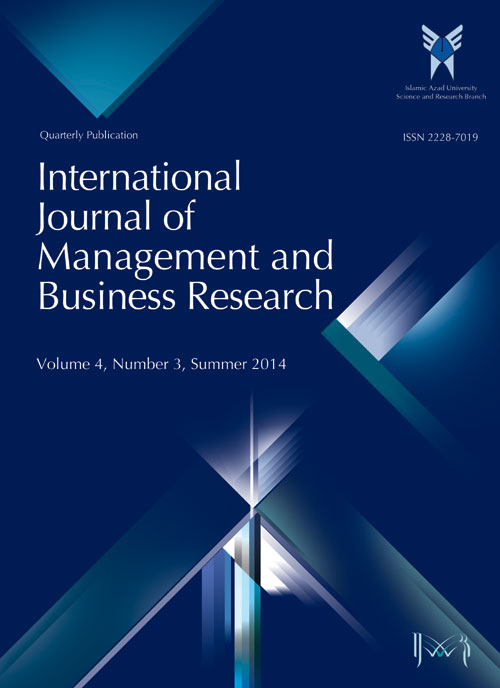فهرست مطالب

International Journal of Management and Business Research
Volume:4 Issue: 3, 2014
- تاریخ انتشار: 1393/05/15
- تعداد عناوین: 7
-
Pages 165-170the best deal. Nowhere is more real than today business environment which affect the success or otherwise of any business venture. Several authors have attributed failure of businesses particularly small and medium scale enterprises to various factors ranging from training of the entrepreneur to exposure and experience while some analysts opined that business environment could impact on small and medium scale enterprises. Hence, using the logistic regression technique to analyze primary data obtained through a structured questionnaire administered to Eighty small scale businessmen and women operators in Ijebu North Local Government area, (Ogun State) South-West Nigeria, this study seeks to ascertain the nature of the relationship between business environment and the survival of small and medium scale businesses in Nigeria.The obtained result revealed that the model of logistic regression was able to predict the distribution of 72.15% of the observed values of the dependent variable as factors such inflationary trend; infrastructural facilities accessibility and government policy serve as barriers to business growth and survival. Hence, it is recommended that small business operators must developed and adopt scientific and rational business management strategies that will aid and increase their understanding of both their business and its environment in order to facilitate planning and predictions on the most significant factors that affects business survival.Keywords: Business environment, Small scale business, survival, Strategies, Opportunities, Threats
-
Pages 171-184Paper studies the impact of the liquidity, underpricing and ownership up on both the short term and long term performance of the Initial Public Offer (IPO) stocks in the equity markets of India. Empirical analysis is undertaken to study the impact of liquidity, underpricing and ownership on Performance of IPO stocks. Multiple regression analysis is undertaken for analyzing the impact. It is found that the short term and long term performance of underpriced IPO stocks is highly dependent on the amount of underpricing at IPO time, Whereas the overpriced IPO stocks depends on the long term liquidity characteristics for the long term performance. However the market adjusted returns are influenced by the liquidity in the long term and non-significantly by the underpricing. Holistic model built in the study explains 80 percent variance of first week returns, 30 percent variance of first year returns and 20 percent variance in the 3 years returns. Inclusion of Ownership structure and liquidity variables in the model provides better explain ability of the IPO stocks performance in the long term.Keywords: IPOs, liquidity, Ownership Structure, performance, Underpricing
-
Pages 185-202Training is considered an important element in the organization, as it heavily influences people to learn how to be more effective at work by modifying knowledge, skills or attitudes through the learning experience to achieve a successful performance. Likewise, training is a long term allegiance to all employees because they have to learn new skills and knowledge which become a turning point for their success in the workplace, moreover the behavior modifications will occur after the training process because they have to come forth with a novel style of managing things. For instance, employees have to apply safe manual handling techniques to ascertain all the processes of the work completed manually. Instead the training involves two-way communication between the trainer and the person learning. However, training does not mean sitting in a room while listening to the speaker otherwise simply watching a video for our reference to implement own selves whatever we had seen in a video. Parenthetically, training can be formal or informal otherwise off or on the job. Training is widely understood as a communication directed because training focuses on what needs to be known to attain the purpose of developing skills, changing behavior, and increasing competence. As a result of this study, employees and employers are likely to deliver a better understanding in recognizing the importance of training that reveals in the employee’s work commitment and performance. Future research should further explore the same independent variables and its effect on trainers’ performance for postgraduate studies at University. Another future research could look at the effects of training on public and private school teachers (specific course outlined). Human Resource Management should be aware of this because applicable training can help employee’s to develop their career, while they can commit to the work to increase their performance. As a long term measure to ascertain the effectiveness of the training, performance monitoring system should be set up to work after continuous training to enable an organization to identify the effectiveness of the training to the participants and to identify the basicneeds of training in time will come. This study examined the effect of training on the work commitment, job satisfaction and job performance. The four components of training such as training commitment, training needs assessment, training contents and delivery approaches and training evaluation are important in human resource management One hundred and eighty employees in Malaysia were surveyed for the psychoanalysis. Data from the questionnaires were analyzed using SPSS version 20.0 software. The techniques employed in examining the data included descriptive statistics, reliability analysis, correlation analysis, and regression analysis. The outcomes demonstrated an alpha value of all variables are well above 0.80, which is considered a dependable indicator of national consistency. The correlation coefficients indicate the hard point of the connector between the variables, where a coefficient is considered significant if the p – value is less than 0.05. Overall, the results from this work revealed that training commitment, training needs assessment, training contents and delivery approaches, and training evaluation positively and significantly influence the employee’s work commitment, job satisfaction and job performance.Keywords: Work commitment, performance, Job satisfaction, Training commitment, Training needs assessment, Training contents, delivery approaches, training evaluation
-
Pages 203-212In knowledge-based economy, knowledge has a public good and non-rivalry nature. Firms build their own knowledge stock not only by means of internal R&D and collaboration with partners, but also by means of previously spilled over knowledge of other firms and public research laboratories (such as universities). Firms based on their absorptive capacity, and level of intra-industry and extra-industry knowledge spillover could learn to produce innovative products. SKIN (Simulating Knowledge Dynamics in Innovation Networks) is an agentbase framework to study knowledge dynamics between innovative firms. The basic SKIN framework does not support absorptive capacity and knowledge spillover concepts, so this paper extends basic SKIN framework and adds absorptive capacity and knowledge spillover to it, and experiments -by simulation- the effect of these concepts on organizational learning. The results show that absorptive capacity has a moderating effect on organizational learning. This effect has been measured by the firms'' population, average innovation length, Herfindahl Index and network density.Keywords: Organizational learning, Absorptive capacity, Knowledge spillover, SKIN framework, Agent, based modeling
-
Pages 213-224Oman has made tremendous progress in the last four decades on the back of rising oil prices and this has led to substantial economic activity in oil, construction, industries and services sectors creating an unprecedented demand for labor ranging from professionals, technical experts, educators, highly skilled people in all vocations to low and semi-skilled people including cleaners, gardeners, packers, domestic workers etc. The objective of the current paper is to examine the causal factors which determine the underlying reason for the migration of such contract workers into Oman, and analyze why some factors seem to play a key role in the workers’ decision to migrate while some do not. Primary data was sourced through interview schedule by using a structured questionnaire and the information regarding the respondents migration were collected from 105 respondents (N=105). A Structured Equation model (SEM) was used for both identification and examination of factors that are primarily responsible for migration of low skill workers into Oman. The results showed that 11 out of the 15 factors studied were important in influencing the decision of the workers to migrate while the remaining four were not significant. The research attempts to identify the factors that are critical in explaining the motives that prompt the contract workers to migrate to a new place under uncertain and challenging conditions and throw up important pointers for researchers and policymakers in both the source and destination countries.Keywords: Expatriate, Migration, Contract workers, Nationals, SEM
-
Pages 225-234During the last two decades, financial institutions worldwide have witnessed a lot of stress in managing their margins in wake of the new risks, challenges and increase in the competition posed to them by the factors of liberalization and deregulation. The key to create value and achieve competitive edge lies in the better operational efficiency and productivity of these institutions under such conditions. Since long, banks have been using various ratios to assess their operational performance. Among these, cost to income ratio (CIR) has seen wider acceptability for its simplicity and intuitive nature. The current paper analyses cost to income ratio of commercial banks operating in India with the objective to explore a benchmark cost to income ratio (CIR) which could be used to differentiate banks for their operational efficiency. A comparative analysis has also been undertaken to examine the impact of size and ownership features of banks on their cost to income ratio (CIR). The study as a whole reveals that banks operating in India operate under competitive CIR ratio well in line with the international operational efficiency standards. Also, it is found that size and ownership characteristics influence strongly in determining the operational efficiency of banks operating in India.Keywords: Operational efficiency, Cost to income ratio, Key performance indicators, Safety threshold, Operating margin
-
Pages 235-245Nowadays both part-time as well as regular employees are working in many organizations of Bangladesh. Though many studies have been conducted to know the motivation status of regular employees but no study is found that addressed motivations status of both regular and part-time employees of Bangladesh. Thus, this study is conducted on 300 regular and part-time employees of Bangladesh to know the most motivating factors of both regular and part-time employees. Respondents were asked to identify and rank ten motivation factors in the order of their magnitude. The findings reveal that good salary, job security, good working condition and interesting work are the most important motivating factors for the regular employees, whereas; flexibility of work, interesting work, good salary and good work environment are the most important motivating factor for part-time employees, because most of the part-time employees working in different organizations are either students or regular employees of other organizations. The findings of the study can be useful for managers and human resource (HR) professionals for motivating regular employees as well as part-time employees and thereby achieving the goals of organization more effectively and efficiently.Keywords: Remuneration, Flexibility, Rewards, Recognition, Job security


